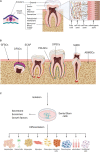Dental Pulp Stem Cells Derived From Adult Human Third Molar Tooth: A Brief Review
- PMID: 34712658
- PMCID: PMC8545885
- DOI: 10.3389/fcell.2021.717624
Dental Pulp Stem Cells Derived From Adult Human Third Molar Tooth: A Brief Review
Abstract
The fields of regenerative medicine and stem cell-based tissue engineering have the potential of treating numerous tissue and organ defects. The use of adult stem cells is of particular interest when it comes to dynamic applications in translational medicine. Recently, dental pulp stem cells (DPSCs) have been traced in third molars of adult humans. DPSCs have been isolated and characterized by several groups. DPSCs have promising characteristics including self-renewal capacity, rapid proliferation, colony formation, multi-lineage differentiation, and pluripotent gene expression profile. Nevertheless, genotypic, and phenotypic heterogeneities have been reported for DPSCs subpopulations which may influence their therapeutic potentials. The underlying causes of DPSCs' heterogeneity remain poorly understood; however, their heterogeneity emerges as a consequence of an interplay between intrinsic and extrinsic cellular factors. The main objective of the manuscript is to review the current literature related to the human DPSCs derived from the third molar, with a focus on their physiological properties, isolation procedures, culture conditions, self-renewal, proliferation, lineage differentiation capacities and their prospective advances use in pre-clinical and clinical applications.
Keywords: dental pulp stem cells; hepatogenic and pancreatic differentiation; heterogeneity; human DPSCs; immunomodulation; surface markers.
Copyright © 2021 Al Madhoun, Sindhu, Haddad, Atari, Ahmad and Al-Mulla.
Conflict of interest statement
MA is employed by Biointelligence Technology Systems S.L., Barcelona, Spain. The remaining authors declare that the research was conducted in the absence of any commercial or financial relationships that could be construed as a potential conflict of interest.
Figures

References
-
- Abd-Elmeguid A., Yu D. C. (2009). Dental pulp neurophysiology: part 1. Clinical and diagnostic implications. J. Can. Dent. Assoc. 75 55–59. - PubMed
-
- Aimetti M., Ferrarotti F., Cricenti L., Mariani G. M., Romano F. (2014). Autologous dental pulp stem cells in periodontal regeneration: a case report. Int. J. Periodontics Restorative Dent. 34 s27–s33. - PubMed
-
- Aimetti M., Ferrarotti F., Gamba M. N., Giraudi M., Romano F. (2018). Regenerative treatment of periodontal intrabony defects using autologous dental pulp stem cells: a 1-year follow-up case series. Int. J. Periodontics Restorative Dent. 38, 51–58. - PubMed
-
- Akpinar G., Kasap M., Aksoy A., Duruksu G., Gacar G., Karaoz E. (2014). Phenotypic and proteomic characteristics of human dental pulp derived mesenchymal stem cells from a natal, an exfoliated deciduous, and an impacted third molar tooth. Stem Cells Int. 2014 457059. 10.1155/2014/457059 - DOI - PMC - PubMed
Publication types
LinkOut - more resources
Full Text Sources

